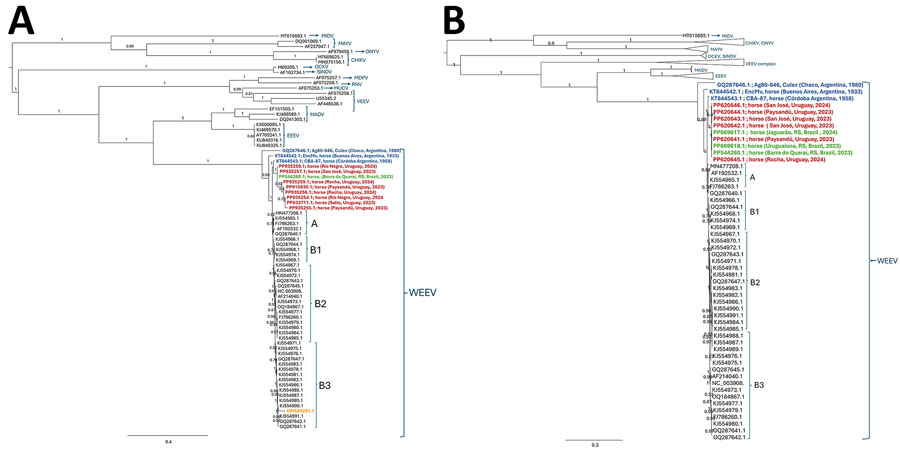Volume 31, Number 1—January 2025
Research Letter
Equine Encephalomyelitis Outbreak, Uruguay, 2023–2024
Figure 2

Figure 2. Maximum-likelihood phylogenetic analysis of alphavirus sequences from South and North America and WEEV sequences described in investigation of equine encephalomyelitis outbreak, Uruguay. A) Phylogeny based on partial nonstructural protein 4 gene sequences. B) Phylogeny based on complete sequences. GenBank accession numbers are provided. Subclades are assigned as previously described (5,6). Clades including reference sequences from other alphaviruses were collapsed for better visualization. Red, sequences from Uruguay 2023–2024; orange, 2009 sequences; blue, sequences from Argentina; green, sequences from Brazil. Branch numbers are approximate likelihood ratio supports. Scale bar indicates substitutions per site. CHIKV, chikungunya virus; EEEV, Eastern equine encephalomyelitis virus; MADV, Madariaga virus; MDPV, Mosso das Pedras virus; MIDV, Middelburg virus; MAYV, Mayaro virus; MUCV, Mucambo virus; OCKV, Ockelbo virus; ONYV, o'nyong-nyong virus; RNV, Rio Negro virus; SINDV, Sindbis virus; VEEV, Venezuelan equine encephalitis virus; WEEV, Western equine encephalomyelitis virus.
References
- Sánchez-Seco MP, Rosario D, Quiroz E, Guzmán G, Tenorio A. A generic nested-RT-PCR followed by sequencing for detection and identification of members of the alphavirus genus. J Virol Methods. 2001;95:153–61. DOIPubMedGoogle Scholar
- Moreira Marrero L, Botto Nuñez G, Frabasile S, Delfraro A. Alphavirus identification in neotropical bats. Viruses. 2022;14:269. DOIPubMedGoogle Scholar
- Katoh K, Rozewicki J, Yamada KD. MAFFT online service: multiple sequence alignment, interactive sequence choice and visualization. Brief Bioinform. 2019;20:1160–6. DOIPubMedGoogle Scholar
- Guindon S, Dufayard JF, Lefort V, Anisimova M, Hordijk W, Gascuel O. New algorithms and methods to estimate maximum-likelihood phylogenies: assessing the performance of PhyML 3.0. Syst Biol. 2010;59:307–21. DOIPubMedGoogle Scholar
- Bergren NA, Auguste AJ, Forrester NL, Negi SS, Braun WA, Weaver SC. Western equine encephalitis virus: evolutionary analysis of a declining alphavirus based on complete genome sequences. J Virol. 2014;88:9260–7. DOIPubMedGoogle Scholar
- Bergren NA, Haller S, Rossi SL, Seymour RL, Huang J, Miller AL, et al. “Submergence” of Western equine encephalitis virus: Evidence of positive selection argues against genetic drift and fitness reductions. PLoS Pathog. 2020;16:
e1008102 . DOIPubMedGoogle Scholar - Delfraro A, Burgueño A, Morel N, González G, García A, Morelli J, et al. Fatal human case of Western equine encephalitis, Uruguay. Emerg Infect Dis. 2011;17:952–4. DOIPubMedGoogle Scholar
- Somma Moreira RE, Campione-Piccardo J, Russi JC, Hortal de Giordano M, Bauzá CA, Peluffo G, et al. Arbovirus en el Uruguay. Arch Pediatr Urug. 1970;41:359–63.
- Burgueño A, Frabasile S, Díaz LA, Cabrera A, Pisano MB, Rivarola ME, et al. Genomic characterization and seroprevalence studies on alphaviruses in Uruguay. Am J Trop Med Hyg. 2018;98:1811–8. DOIPubMedGoogle Scholar
1These first authors contributed equally to this article.
2These authors contributed equally to this article.